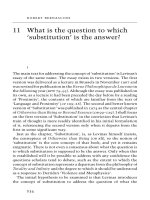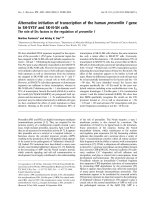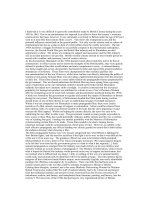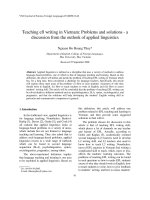in what ways and to what effect did the british cinema of the second world war mobilize support for th
Bạn đang xem bản rút gọn của tài liệu. Xem và tải ngay bản đầy đủ của tài liệu tại đây (47.7 KB, 4 trang )
I think that it is very difficult to ignore the contribution made by British Cinema during the years
1939 to 1945. Due to an entertainment tax imposed in an effort to boost the country' s economy
cinema prices had risen, however, 'it was calculated, everybody in Britain under the age of 40 (sic)
went to at least fifty three feature films a year'1. This shows the widespread access and the
potential influence cinema had on the general public. Not only was the cinema used as a place of
entertainment but also as a place to hear of current affairs from the weekly newsreels. The late
1930s had been a struggle for Britain to successfully compete in the international marketplace,
however, the Second World War gave the British film industry and its filmmakers an ideal
opportunity to shine. The nation was looking for support and reassurance and the film industry
was in an ideal position to do just that. British wartime cinema entered its most fruitful period on
record with a sudden, and necessary, burst of creative activity.
As the documentary filmmakers of the 1930s had previously discovered their role to be that of
commentator, to reflect society and to mirror the strengths of the British public, they were quickly
utilised to produce films that would inform and unite a population in crisis. A national identity
was being sought and, at last, documentary had found its niche and enjoyed the greatest audience
attendances of its history. These films were championed for their realistic qualities and
non-sensationalism of the war. However, whilst docu-realism was directly informing the public of
wartime events purely fictional films were providing a light-hearted distraction from the atrocities
of daily life. These films echoed in a more subtle fashion the propagandist themes perpetuated by
the government. This newfound enthusiasm for British film may have sprung from a growing
sense of patriotism as the war intensified, indeed it should not be believed that filmmakers
suddenly developed new cinematic skills overnight. It could be contested that this increased
popularity for homegrown product was attributed to a desire to see a 'true' reflection of Britain
after the uninspiring cycle of music hall comedies and documentaries produced during the 1930s.
A body was formed by the government to regulate and control the output of filmmakers in Britain
during the war period. The Ministry of Information decided that films made during wartime
should focus on one of three themes to carry an underlying message of strength and power.
Whilst it was not compulsory for filmmakers to make propaganda films, there were certain
incentives if a film carried a message of support or nationalism. Artists could be released from
their military ranks if a script was deemed suitable in the hope that the star's appearance would
increase the film's appeal. Whilst not helping the country directly, the actor was seen to be
mobilising the war effort in other ways. The government wanted as many people as possible to
have access to these films that would potentially influence public opinion and this was a realistic
way of reaching that goal. Funding was another possibility with the Ministry of Information
commissioning certain films to be made. These films tended to be shorts, hoping that an
important message could be communicated in a brief space of time. However, as subtlety is the
most effective propaganda, any official funding was closely guarded to ensure that it didn't affect
the audience decision when choosing a film.
The three propagandist themes were very loosely categorised into 'what Britain is fighting for',
'how Britain fights', and 'the need for sacrifices if the fight is to be won' so that it was difficult for
a film not to fit in some way. The guidance offered was seen to be limited which prompted
Michael Balcon to write a letter to The Times newspaper in January 1943 expressing his disgust
as he felt that 'at no time has the government given us a lead in what it has required [ ] Such
national propaganda as emerged from the industry was made entirely on its own initiative and
certainly without an overall scheme of propaganda.'2 The Ministry of Information, whilst it knew
what it hoped the British film industry would provide in the way of support and motivation, had
not realised what a difficult task lay ahead. Little, or nothing, in the way of a national identity
could easily and automatically be identified with by the public at large. The film industry had to
integrate all that it believed made Britain unique, more ostensibly English, into easily identifiable
packages for effortless consumption by its audience. There was little that had been seen on
cinema screens prior to the war that could be instantly recognised as Britain or British.
Echoing these thoughts, Antonia Lant in her essay Blackout: Reinventing Women for Wartime
British Cinema also realised that 'the stuff of national identity had to be winnowed and forged
from the traditional aesthetic and narrative forms, borrowed from the diverse conventions of
melodrama, realism, and fantasy, and transplanted from literature, painting, and history, into the
cinema.'3 Previous texts of the 1930s had portrayed a very regionalised picture of Britain,
splitting the nation by class and gender with very definite boundaries. The northern working
classes were portrayed in an almost cartoon like fashion and were often included in films for
comedy relief. Strict guidelines were therefore enforced to raise the cultural and intellectual levels
of the general public whilst also moderating the amount of information they were exposed to
whether it be on the weekly newsreels or a feature film. The general spirit of each film had to be
one of strength and unity, portraying positive images despite the suffering that continued around
the audience daily. Cinemas were open daily varying their programme weekly. 'It took a war to
compel the British to look at themselves and find themselves interesting'4 Dilys Powell remarked
and I believe that this epitomises the way in which wartime propaganda theory helped British film
to find an identity for Britain and the British that would persist.
As the war affected everybody cinema audiences became easier to target as class and other
regional barriers were broken. Everyone had to help each other through whatever difficulties they
faced. This newfound patriotism spread and audiences wanted to see themselves depicted on film
whether in real or fictional situations. The unifying effect of the war also extended to cinema
attendance. Cinemas were seen to be a refuge from daily life and, with a shortage of other
entertainments, film not only provided an escape but also a safe haven from the dangers of falling
bombs. Despite on screen warnings of impending air raids, many patrons chose to stay in their
seats as they felt safer in the cinema than in their own homes due to the structure of the buildings.
The use of 'story' documentary was popular in portraying real situations, often using real people
instead of actors, to reflect a nation united in her difficulties. Although often wooden, these new
'stars' exposed 'real' life in narrative form for the audiences back home. Critics preferred this
documentary style of reporting and praised the way in which a new national cinema was emerging
at a time when it was needed most. The realist approach was seen to be more honest, if not quite
so entertaining as 'the national ideal remained [ ] The national disgrace was the dingy
sensationalism of No Orchids For Miss Blandish (1948), or They Made Me A Fugitive (1947) and
its fellow spiv dramas'.5 To Roger Manvell and his fellow film historians these realist features
helped the British public to rediscover themselves, and to recognise the strengths each individual
possessed. The situations presented were, at last, 'real' and not distortions of the truth as had been
previously depicted. The characters had a sense of power and ability despite their background.
Many women found that, for the first time, they had a controlling power. They could have a
second role alongside that of wife or mother, and by 1944, seven and a half million women were
working outside of the home.6 It was realised to be an advantage that only in these difficult times
could one's true potential be harnessed. Employed in a variety of roles, women were given the
opportunity to challenge their previously subservient positions, they were made to realise that their
part in daily life was as important to the war effort as those on the frontlines. The government
noted this newfound confidence and encouraged filmmakers to make sure that every effort was
made to reflect and encourage it. In Millions Like Us (1943) both actuality and fictional narration
were used to portray the various roles of conscripted women across different classes. The film
hides the obvious propaganda message of 'you can help your country just as much in an overall as
you can in a uniform'7 whilst tackling issues of love and looking forward to a post war society.
The fact that women should be relied upon to be glamorous and feminine was a further underlying
feature and, once the war was over they could, again, return to their lives of domesticity should
they choose to do so. Despite this portrayal, the government did not show any concerted effort to
encourage women back into the home once the war was over as had been done after World War I.
It had now been recognised that here was a strong workforce that could be utilised long after the
war had ended.
Women were given much greater prominence in films during the war period, not least because
they now made up the vast part of cinema audiences as the men had been conscripted, but mainly
because their contribution was vital to the war effort. They were being reassured and praised for
their contributions in a wide variety of films. The true experiences of women during this time,
however, were rarely commented on. Most films concentrated on the periphery of daily life, such
as friendships and work, rather than the real struggle to maintain a family whilst working long
hours, enforced rationing, coping without loved ones and the very real temptation of extra-marital
affairs. Whilst the Ministry of Information were not unaware of these issues they wanted to
maintain an image of strength. These problems could only be seen as weaknesses to be eradicated
or mistakes to be penalized. Audiences did realise that films were not 'moral instruction manuals
to prove that sins are punished, that unhappy ends don't flow from sins whose avoidance would
have brought a happy end. And that unhappiness can hit us as arbitrarily as a German bomb, or
illness, or fatal complications in childbirth.'8 The Ministry of Information, and filmmakers, were
aware that women were becoming more adventurous with their sexuality. Fashion was becoming
more important and films began to reflect this fresh, new liberty. Censorship ethics, whilst much
more relaxed during the war years, still prevented many of these topics from being discussed
openly but suggestions of promiscuity were more prevalent in films towards the end of the war. In
Love Story (1944) the main character knows that she will die within six months and has nothing to
lose by expressing her sexuality freely. As the nation lived under the constant threat of death the
film seemed to echo the general feeling of living for the day. The film concludes with 'the
happiness we have is worth grasping - if only for a day or an hour'9.
In spite of the increasing transformation of women and their role in society, and whilst many
women felt as though they had been freed from their shackles, most women were utterly exhausted
by the demands being made on them. However, they found their new challenges to be refreshing
and empowering. This common feeling forged an ever-growing solidarity amongst women from
different social backgrounds that would change the portrayed image of women in British film
forever.
Whilst the type of films being produced was varied throughout the war, cinema audiences were
becoming increasingly restless with the prominently documentary repertoire. Realism and the
unsensational documentary drama was no longer sufficient to entertain the masses and demand
was growing for the dramatic and entertaining films from studios such as Gainsborough. These
films offered fantasy, escapism and the hope that an end to the war was in sight. However, not all
critics approved of this blithe approach to production. Whilst the war continued, many films'
content was seen to be trivial, avoiding confronting the important issues of the day. A rare
exception to this rule seemed to be Henry V (1944) which being a historical representation, and
Shakespeare play, was worthy of note. 'The success of Henry V challenges the assumption [ ]
that documentary style realism is the sole criterion of propaganda [ ] the use of Shakespeare, the
writer privileged above all others in discourses on English heritage, might be seen as an attempt
by the propagandists to assert their own officially legitimated culture with audiences. [ ] In this
sense Henry V perfectly exemplifies the operation of British film propaganda.'10 Patriotism and
nationalism reverberated through the film whilst not on the same scale or with the same resonance
that had been previously experienced in the documentaries of the early 1940s. Nonetheless, the
film made cinema audiences sit up once again and pay attention to the fact that they needed to
remain united in order to win the war. The film also had a second equally important role. To
project an image of Britain across the world. Whilst most films were open for consumption on the
world market, few caught international attention like this period drama. The long-term hope was
to prove British cinema could hold its place in the international marketplace. In order to do this a
high quality threshold had to be maintained. Following from Korda's Private Life of Henry VIII
(1933) Henry V was a prestige production whose nationalistic themes reflected the propagandist
themes desired by the government. Here was the hope for the future, a utopia hat never really
stayed for very long.
To conclude, I believe that the British film industry truly found its strength and character during
the early 1940s. Film was utilised as an effective tool to not only support and reassure a nation
facing difficulty, but to project this image across the water. Film production may have been
inhibited by strict controls of rationing and censorship but never before, or since, has British
cinema experienced such a buoyant period.
Notes.
1.Geoffrey MacNab, J. Arthur Rank and The British Film Industry (London: Routledge, 1994),
p.37.
2.Penelope Houston, Went the Day Well? (London: British Film Institute, 1992), p.25.
3.Angela Lant, 'Blackout: Reinventing Women for Wartime British Cinema' (Princeton, NJ:
Princeton University Press, 1991), p.31 in The British Cinema Book, ed. by Robert Murphy
(London: British Film Institute, 1997), p.71.
4.Dilys Powell, 'Films Since 1939' (London, 1947), p.28 in British Cinema. The Lights That
Failed. James Park (London: BT Batford Ltd, 1990), p.69.
5.Geoff Brown, 'Paradise Found and Lost: The Course of British Realism', in The British Cinema
Book, ed. by Robert Murphy (London, BFI Publishing, 1997), pp.187-197 (p.188).
6.Robert Murphy, Realism and Tinsel: Cinema and Society in Britain 1939-1949 (London:
Routledge, 1989) p.99.
7.Ibid., p.58.
8.Raymond Durgnat, 'Some Lines of Inquiry into Post-war British Crimes', in The British Cinema
Book, ed. by Robert Murphy (London, BFI Publishing, 1997), pp.90-102 (p.92).
9.Sue Aspinall, 'Women, Realism and Reality in British Films, 1943-53', in British Cinema
History, ed. by James Curran and Vincent Porter (London: Weidenfield and Nicolson, 1983),
pp.272-293 (p.275).
10.James Chapman, 'Cinema, propaganda and national identity: British Film and the Second
World War', in British Cinema, Pas and Present, ed. by Justine Ashby and Andrew Higson
(London: Routledge, 2000), pp.193-206 (p.204).
Bibliography.
Aldgate, Anthony and Jeffrey Richards, eds., Best of British. Cinema and Society from 1930 to
the Present (London: IB Tauris, 1999)
Ashby, Justine and Andrew Higson, eds., British Cinema Past and Present (London: Routledge,
2000)
Betts, Ernest, The Film Business (London: Allen & Unwin, 1973)
Curran, James and Vincent Porter, eds, British Cinema History (London: Wiedenfield and
Nicolson, 1983)
Dickinson, Margaret and Sarah Street, Cinema and State. The Film Industry and the British
Government 1927-1984. (London: BFI, 1985)
Houston, Penelope, Went The Day Well? (London: BFI, 1992)
MacNab, Geoffrey, J. Arthur Rank and the British Film Industry (London: Routledge, 1994)
Murphy, Robert, Realism and Tinsel: Cinema and Society in Britain 1939-1949 (London:
Routledge, 1989)
Murphy, Robert, ed., The British Cinema Book (London: BFI, 1999)
Park, James, British Cinema. The Lights That Failed (London: BT Batford, 1990)









